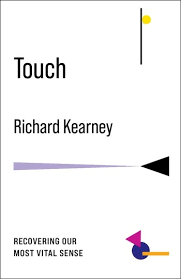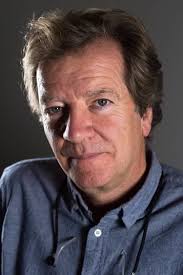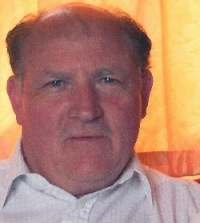Getting in touch with touching
and Saint Patrick’s days of yore
Saint Patrick was a gentleman, he came from decent people,
In Dublin town he built a church and on it put a steeple
His father was a Callahan, his mother was a Grady,
His aunt was an O'Shaughnessy and uncle he was Brady.
So says Christy Moore.
At this time of year, my mind always flies back to the
5th century. And to my own native heath of West Wicklow. You see,
according to one legend, our area was Christianised before Saint
Patrick; we were converted by Palladius. (One local wag said that we
were Christianised sometime B.C.)
Other historians claim that Palladius was repulsed by
the inhabitants of Wicklow, where he landed. ... One way or the other
it’s generally accepted that Naomh Padraig didn’t set foot in our neck
of the woods.
But the late Jimmy Freeman of Ballyknockan, had a more down-to-earth explanation. He told me, and I quote,
“Saint Patrick stood at Burgage an’ he come no farther. An’ he pointed
his staff up at Lacken, Kylebeg an’ Ballinastockan an’ he sed ‘Let that
be a den of thieves an’ robbers forever more’ .
I didn’t know what to make of it. I thought, perhaps,
he was indulging in a bit of, good-natured, inter-Townland rivalry.
Being well aware of the God-fearing and law-abiding nature of the
inhabitants of the places in question it looked like our National
Apostle was out beside it. Oh, sure enough, a Ballinastockan man was
once fined sixpence for riding an unlit bicycle in Blessington during
the hours of darkness. And it was rumoured that (before my time) a
farmer on the Kylebeg/Lacken border was prosecuted under the 1910
Noxious Weeds Act, but nothing serious.
You see, as a community, we were always as honest as
hard times would. But the inhabitants or more progressive areas used to
say that we only knew that Christmas was over when we saw people
wearing shamrock. We know that Saint Patrick is buried in
Downpatrick, Having died at Nearby Saul in 561. March 17th is the
supposed date of his death. We can’t check. RIP.IE doesn’t go back that
far. He was born in 486 and journalist, Billy Keane, has done a lot of
genealogical research but failed to find any evidence of an exact date
for the saint’s birth. Consequently, Billy suggests that his feast day
(Saint Patrick’s not Billy’s) should be moved to September.
Any date in September save 19th to 25th inclusive.
Because that would clash with Listowel races. However, it looks like
we will be stuck with the current date for the foreseeable future. Of
course the nostalgia associated with our National holiday varies from
person to person. As children, if we were abstaining from penny toffees
and Fizz bags for Lent there was an exemption on Saint Patrick’s Day.
Adults off the booze and /or the fags got a one-day reprieve.
Retailers have always loved it. Even the most humble huckster’s
emporiums look like Carroll’s souvenir shops there’s so much green. You
see, psychologists have established that green is the easiest colour on
human vision, projecting a relaxed image and environment; it indicates a
friendly approach and prompts shoppers to buy.
For my own part my olfactory sense goes back ever the
decades whenever my nostrils detect the exhaust fumes, however
tentative, given off by a forty to one fuel mix. Immediately I am back
on any Saint Patrick’s Day in the 1950s When Ireland’s top scramblers
are negotiating rough terrain at Templeboden Bridge. Despite
muck-splattered helmets and goggles, older spectators were able to point
out to us some of the all-time greats. Harry Lynsdsney, Ernie Lyons
and Stanley Woods, Harry Lambert et al. And, in my mind's ear, I can
hear the frantic revving of Nortons, BSAs and Bultaco bikes as the
aforementioned and competitors from all over this island would halt for a
time-check. In 2001 in the bitter New York wind I marched up
Fifth Avenue as part of the Saint Patrick’s Day parade. It was my first
visit to the Big Apple. I still have the costume that I wore that day
**** Saint Patrick’s name features in everything from Cathedrals to
football clubs to middle names taken at Confirmation.
And . . . in 1757 the owners of Rowes Distillery,
in Thomas Street, Dublin built the highest smock windmill in Europe on
their 17-acre site, to power their distillery. The tower still stands
to this day. Because of the shape of its dome it has been known to
generations of Dubliners as “The Onion Tower” but its official name is
Saint Patrick’s Tower but . . . did Saint Patrick turn back at Burgage?
The jury is still out. Perhaps in the future through carbon dating, DNA
of some other science yet unknown, Jimmy Freeman will be proved wrong .
. . or right.
* * * * *

 |
Sir Walter Scott referred to, “ . . . the exquisite touch, which renders ordinary commonplace things and characters interesting.”
In the Ireland of my youth there wasn’t a great tradition of
touching as a gesture of affection. A “Toucher” was a fellow who
usually had his hand out for the price of a drink. Richard Kearney is
an Irishman, who holds the Charles Seeling Chair of Philosophy at Boston
College. He jokingly writes that people in Ireland to which I refer, “
Only touched when they were drunk ( south of the border) or trying to
kill each order (north of the border .) Although he has a wonderful
turn of phrase he is not joking in the 202 pages of his latest book, Touch, in which he agrees with Freud that, “No mortal is ever silent. If he does not speak with his mouth he stammers with his fingers.”
Because of social distancing, there is less touching, in
Ireland than ever before. Strange as it might seem there are people on
this island who haven’t shook hands with another human being for a year.
After twelve months of such deprivation it’s interesting to be reminded of what we are missing.
The author advises us to “get back in touch with touch."
Kearney, a true philosopher gives us some frightening statistics
about loneliness and points out how lack of touching leads to
“excarnation.” His advice? “ . . .we have learned from Covid
how much we miss touch “ . . .it is no accident that skin is our largest
organ and that we are born and die naked. We need computers but we also
need carnality.” Touch is a wonderful and informative pick-me-up in a world in turmoil.
A must-read.
See you in April
Click on author's byline for bio and list of other works published by Pencil Stubs Online.






No comments:
Post a Comment